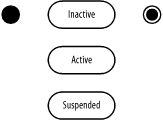|
|
|
7.1 StatesAs discussed in Chapter 2, as elements communicate with one another within a society of objects, each element has a lifecycle in which it is created, knows something, can do something, can communicate with other elements to request processing of those other elements, can have other elements communicate with it to request processing of it, and is destroyed. A state is a specific condition or situation of an element during its lifecycle. Define the states for your elements. The current state of an element is called its active state, and the element is said to be "in" that state. There are various types of states, including simple, initial, and final states. The next few sections discuss these different types of states. 7.1.1 Simple StatesA simple state indicates a condition or situation of an element. For example, the project management system may be in one of the following simple states:
In the UML, a simple state is shown as a rectangle with rounded corners and labeled with the name of the state or a description of the situation of the element. Figure 7-1 shows the various states associated with the project management system. Figure 7-1. Simple states 7.1.2 Initial and Final StatesAn initial state indicates the state of an element when it is created. In the UML, an initial state is shown using a small solid filled circle. A final state indicates the state of an element when it is destroyed. In the UML, a final state is shown using a circle surrounding a small solid filled circle (a bull's eye). Figure 7-2 updates Figure 7-1 with an initial state and final state. A state diagram may have only one initial state, but may have any number of final states. Figure 7-2. Simple, initial, and final states |
|
|
|